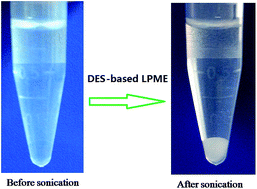Deep eutectic solvent-based liquid-phase microextraction for detection of plant growth regulators in edible vegetable oils
Abstract
In this study, a series of tunable DESs were prepared and used for the liquid-phase microextraction of plant growth regulators, including indole-3-acetic acid, indole-3-butyric acid and 4-iodophenoxyacetic acid, from a multi-component edible vegetable oil matrix. Of the several types of DESs composed of different hydrogen acceptors and hydrogen bond donors, the DESs formed by tetramethylammonium chloride–ethylene glycol (in a 1 : 3 molar ratio) showed the best extraction efficiency, and 30 μL of the DESs yielded the highest efficiency of all volumes tested in the range of 10–50 μL. Extraction equilibrium was reached in only 7 min of ultrasonication under 50 °C. Under the optimum conditions, a good linearity was obtained for 3.0–50 μg mL−1 of indole-3-acetic acid, 1.2–58 μg mL−1 of indole-3-butyric acid and 7.5–75 μg mL−1 of 4-iodophenoxyacetic acid, with the correlation coefficients no less than 0.9980. Both the limits of detection (LODs) and limits of quantification (LOQs) were satisfied and could meet the requirements of the applications in oil samples. The study demonstrated that DESs could be used as efficient liquid-phase microextraction media for analysis of plant growth regulators in edible vegetable oil samples.


 Please wait while we load your content...
Please wait while we load your content...